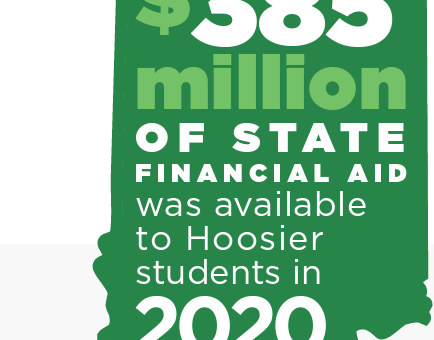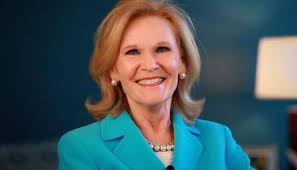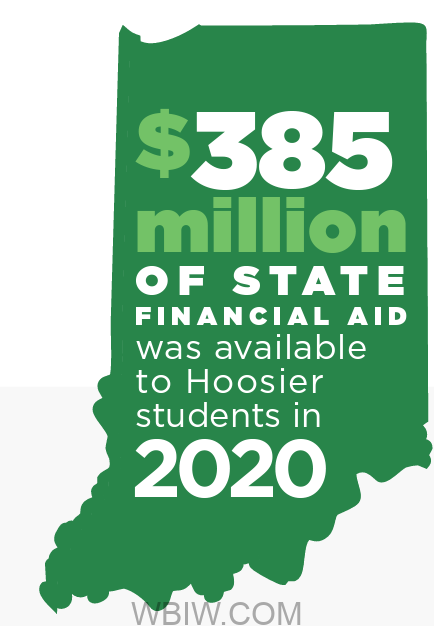
INDIANA – Most Hoosier students do not pay the full price to go to college due to efforts from Indiana’s public institutions to maintain some of the lowest tuition rate increases in the nation and from state lawmakers to provide generous financial aid resources, according to the Indiana Commission for Higher Education’s latest College Costs and Financial Aid Report.
The Commission’s first-of-its-kind report provides an analysis of the total cost of attendance at all Indiana public institutions, which includes tuition, mandatory fees, books, room and board, transportation, and other needs. The report also analyzes the average debt load for college graduates and the impact state and federal financial aid has on reducing the cost for Hoosier students and families.

“Cost is one of the most important factors for anyone considering education and training beyond high school and the findings in this report will help students and families make informed decisions regarding their higher education pathways and bring awareness to the financial aid opportunities available in Indiana,” said Indiana Commissioner for Higher Education Teresa Lubbers.
Each year, the State of Indiana makes $385 million in grants and scholarships available to students. When combined with federal financial aid, on average, Hoosier financial aid recipients receive more than $8,000 in grant and scholarship aid per year. Additionally, tuition rate increases for both two- and four-year institutions in Indiana are lower than the national average (7.5 percent for four-year institutions, compared to a national rate of 11 percent).

While Indiana has been committed to increasing its financial aid expenditures, higher education appropriations as a percentage of the state budget have decreased over a decade and lag the national average by nearly $2,000. Higher education appropriations fund programs such as Indiana’s public institutions’ operations and state financial aid support.
“Insight into the true costs of college has never been more important as the college-going rate in Indiana and nationally has continued to decline over the past several years,” said Lubbers. “We need to provide assurances to Hoosiers that higher education can be an affordable option.”
State aid keeps the cost of higher education within reach for Hoosiers with financial need
Indiana ranks first in the Midwest and fifth in the nation in providing need-based aid, and these resources help bring college within reach for many low-income Hoosier students and families. After grants and scholarships, students from families with a household income of less than $30,000 pay just over a quarter (30 percent) of the average college costs per year.
One example of Indiana’s need-based aid is the 21st Century Scholarship. The program, which requires students to apply while they are in seventh or eighth grade, offers income-eligible Hoosiers up to four years of paid tuition at a participating Indiana college or university.
“The 21st Century Scholars program eliminates the largest cost of college – tuition – for low-income Hoosier students,” said Lubbers. “By decreasing financial barriers, we are seeing Scholars go to college at higher rates than their peers, including students from high-income households.”
Indiana’s outcomes-based funding formula pays for what the state values
For nearly two decades, state policymakers have embraced an outcomes-based funding formula for public institutions that rewards completion and places a large premium on on-time completion. The formula includes an on-time graduation rate metric that recognizes the value of 2- and 4-year institutions increasing students’ likelihood of success by graduating on time while reducing the overall cost per degree. Extended-time completion leads to unnecessary costs for students. Two additional years in college can cost $50,000 or more in lost wages, tuition, and related costs.
“The most cost-effective degree is an on-time degree,” said Lubbers. “Indiana’s outcomes-based funding formula drives dollars to colleges based on student success outcomes that ensure personal prosperity and economic mobility. The Commission has reviewed and updated the formula over time to respond to and reflect changes taking place for learners and for the state’s needs.”
Recommendations
The Commission releases recommendations with each of its reports, offering strategies aligned to its strategic plan, Reaching Higher in a State of Change, which calls for a decrease in the cost of college and a reduction in the reliance on student debt to increase completion and promote lifelong success. Recommendations include:
- Increasing college readiness with high school students by encouraging greater access to dual credit opportunities and requiring all high school seniors to file the FAFSA (with opt-out provisions embedded)
- Continuing to make college more affordable by urging Indiana public institutions to adhere to the Commission’s non-binding tuition and fee recommendations, continuing to incentivize students and institutions for on-time completion through an outcomes-based funding formula and encouraging institutions to use Open Educational Resources to reduce costs
- Supporting low-income and first-generation students by advocating for all institutions to provide transparent information about financial aid opportunities available to first-generation students and explore options to offer financial support for socioeconomic barriers such as food, transportation, housing and childcare
- Increasing financial literacy with students and families through partnerships with community organizations such as INvestEd which work directly with K-12 students so they make informed, responsible borrowing decisions to limit excessive debt after college
Read the full College Cost and Financial Aid Report at che.in.gov. Data come from the Indiana Commission for Higher Education, Indiana State Budget Agency, U.S. Department of Education, and The Institute for College Access & Success.
Explore resources available to help students plan, prepare and pay for college at www.LearnMoreIndiana.org.



